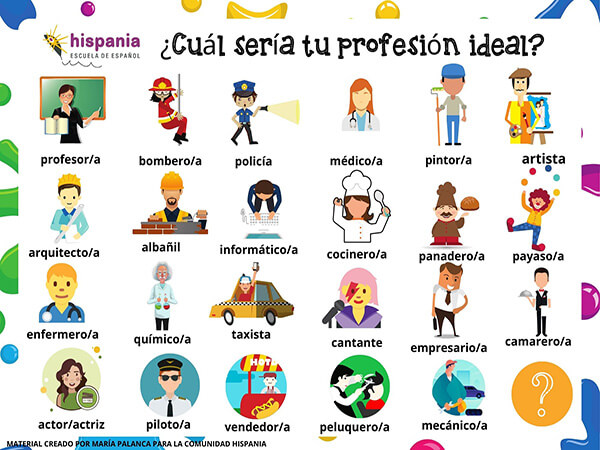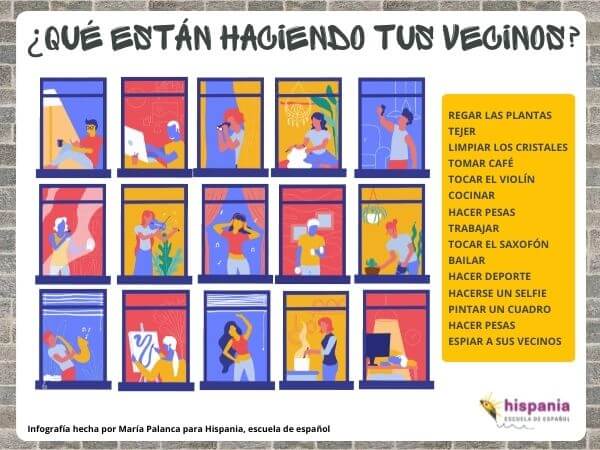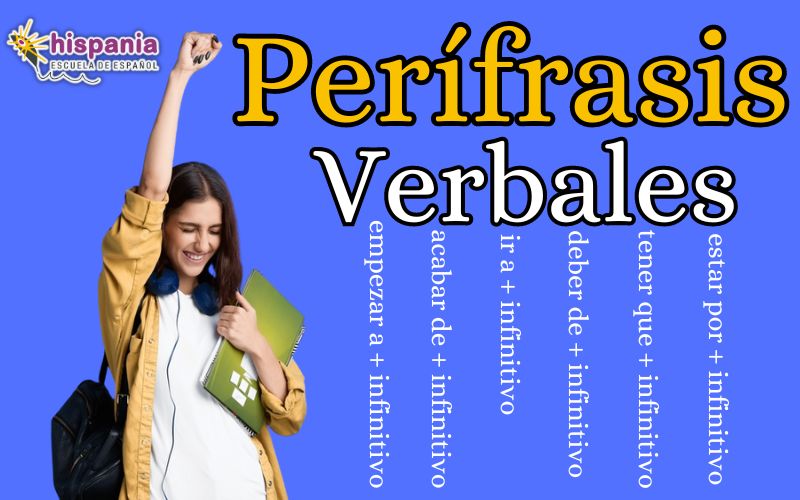
Verbs ser and estar in Spanish: main uses and their differences
Are you a Spanish beginner and finding using ‘ser’ and ‘estar’ a bit difficult?
The differences between "ser" y 'estar' for foreigners they are always difficult to understand.
Imagine this, it’s your first ever Spanish class and you learn the verb ‘ser’, how to conjugate it and how to use it. Up until this point, everything seems to be going very smoothly, right? You most likely have a similar verb in your own language.
You arrive at your second Spanish class and you discover the verb estar… You probably think: “Why does Spanish have two identical verbs? If in my language both are translated by the same verb. What's the use of "ser" y 'estar' in Spanish? Is there really that much difference between being and being? What a mess!”
Sound familiar?
Well, don’t worry because it happens to a lot of people. In Hispania, escuela de español we know that differentiating the verbsser and estar is often a problem for many students studying spanish.
In fact, according to Spanish teachers and students, the great debate proposed by Shakespeare wasn't “ser o no ser” .
The real question was, “SER OR ESTAR?”
So, today we’d like to help you become a verb professional "ser" y 'estar' vocabulary! 💪🏻
Read the article carefully because at the end of it all there is exercises with "ser" y 'estar' in Spanish and I want you to make them phenomenal. 😉
Differences between ser and estar
When starting your Spanish language acquisition journey, it becomes clear that many languages use just one verb which functions as both ‘ser’ and ‘estar’.
But Spanish has two verbs! 😉
This is one of the main characteristics of Spanish, unlike many other languages, such as English.
Therefore, it's often difficult to translate Spanish directly from other languages.
That's why its so important to think in spanish. 😉
But don’t worry, we know that this can be a little tricky to do.
Keep reading to find out the key to mastering the uses of uses of the verb "ser" y 'estar' in Spanish.
Well... ¡Sigue leyendo!
Verb ‘SER’
¿Be o 'estar'? When to use each verb? What is the main difference between "ser" y 'estar'?
As a general overview, the verb 'ser' is used to talk about characteristics that describe people and/or objects .
Meaning that we are usually talking about characteristics that are permanent.
That's not all though!
Let's start with the basics: What is the conjugated "ser"?
Present tense conjugation
Verbs "ser" y 'estar' in its conjugation in present indicative are irregular verbs. Let's start with the the verb "ser".
Don’t be scared though, the verb is extremely short so we are sure it will make it easy for you to remember. 😊
Find below a small table with the verb conjugation 'ser' in present indicative. Take a look, its easy peasy!
Yo SOY
You ERES
Él/ella/usted ES
Nosotros/nosotras SOMOS
Vosotros/as SOIS
Ellos/ellas/ustedes SON
Do you want to know the imperative of the verb "ser" or in other times of the past? Like the past imperfect of the verb "ser". If so, check out our article on verbs haber, ser and estar, since we present you the conjugation of verbs "ser" y 'estar' at all times.
In this article we are only going to look at the verbs "ser" y 'estar' in present and its main uses.
Basic uses of the verb to be
Do you want to know the uses of "ser" y 'estar'?
In this article I will tell you about them. Let's go first with uses of the verb "ser" vocabulary. Now that you have controlled the form, here comes the fun! 😊
Nationality/Origin
We use the the verb'ser'to express someone's nationality or where something originates from. More simply, where they come from .
For example, we can say:
Miguel es de México, es mexicano. (Miguel is from Mexico, Miguel is Mexican).
Therefore, we are able to express Miguel’s nationality in two different ways: by using the preposition 'de' , plus the country or city , or by using a nationality adjective .
La tortilla de patatas es española. (Potato omlette comes from Spain)
In the above, we are explaining what the origin of the famous potato omelette is - where this dish was created.
What do you prefer, the potato omelette with onion or without onion? 😉

Job Titles
To talk about professions we use "ser" o 'estar'? If we want to express what our job title., your job, we use the the verb "ser". For example:
Yo soy profesora de español en Hispania. (I am a spanish Teacher at Hispania)
In this example, we only need to use the verb "ser"plus the job title..
That's it! Simple, right?
As a child how many times were you asked, ‘what do you want to be when you grow up?’
What would you reply? I always said:I want to be a dancer". 😊
Take a look at some job roles we’ve picked out and let us know which one is your favourite.
Identity
We also use "ser" for identify and define at people and objects. For example:
This es Maria, my best friend.
The object we use to write es a pen.
Identification and definition is a very important use of the verb ‘ser’!
Speaking of defining people, "ser" has another very similar use…
Physical appearance and personality
We use ‘ser’ to describe peoplemeaning, we use it to add information to someones character, personality and to describe the appearance PhysicsSo, we could say that María...
...'es una chica rubia y alta. Además, es muy simpática, es divertida y es muy inteligente' - (Maria) is a tall, blonde girl. She is also very kind, she is funny and she is intelligent.
Whilst it’s true that our physical appearance can change a lot over the years, there are certain features that don't change so much, wouldn’t you agree?
Have you thought about how you were as a child and how you are now? Write it on a piece of paper and practice your Spanish a little with our beloved verb "ser". You dare? 😉
Dates
Finally, the verb "ser" can be used to express datesThat is to say, verb tense at which an action specifically happens. For example,
'Mi cumpleaños es el 13 de abril' - My birthday is on the XNUMXth of April.
'Mañana es sábado.' - Tomorrow is Saturday.
Watch out! When we talk about dates, we use the verb "ser" in the third person singularform - which is the same form that we use for people too ‘él, ella y usted’ (he/she). him, her and you.
Easy peasy, right!
Now that you are a super expert in the verb "ser", let's go for the second part of this peculiar couple: the verb 'estar'. 😉
Verb 'ESTAR'
Now you will really understand the difference between "ser" y 'estar'.
El the verb 'estar' is often used to talk about non-permanent informationsuch as, states of being y location de people y objects.
Let's take a look in detail when we should use the verb ‘ser’.
First we need understand how to conjugate the verb, don't you think?
Let’s have a look at the irregular verb in present tense!
Present tense conjugation
With ‘estar’, it is only irregular in the first person singular form, the 'yo' or I form.
A lot easier than conjugating ‘ser’! That’s brilliant news!
Below you can see the verb conjugation of 'estar' in present indicative tense.
Yo ESTOY
You ÉSTAS
Él/ella/usted ÉSTA
Nosotros/nosotras SOMOS
Vosotros/as YOU ARE
Ellos/ellas/ustedes ESTÁN
If you want to know the verb 'estar' in the past tense, such as the past perfect simple of the verb 'estar', I put again the article of the verbs have, be and be.
In this article you will find all the tenses of the verb "ser" y 'estar' in Spanish.
Main uses of the verb estar
You’ve completed the first step, good work! Now you’ll be able to recognise this marvellous verb when you speak and read in spanish. 🤩
We pass to the most interesting: When do we use 'estar'?
Location/Position
We use 'estar' to express location of people and objects . For example:
– ¿Dónde está Hispania, escuela de español? - (Where is Hispania, escuela de español)
-La escuela está en Valencia, está cerca del Jardín de Viveros. - (The school is in Valencia, it is close to the ‘Jardin de Viveros’).
This is perfect when talking or asking for directions. So, pack your bags because you already know how to ask for directions to Spain. ;) 😉
State of being:
El the verb 'estar' also speaks of people's moods, his emotions and its emotions. They are temporary states that changeian, they are not lasting and all people experience them.
We are talking about sensations that may be temporary or may have a specific cause, that is, they do not define the person.
Thus, we say:
Laura is a very happy girl, but today she is sad because her puppy is lost.
The characteristic cheerful and it is stable in Laura, it defines her as a person.
However, today he is in a situation that makes him have a certain feeling: sadness.
physical states
Again, we use the verb 'estar' to describe features that do not define people or thingsTherefore can be temporary. They refer to non-lasting physical changes. It is used a lot with diseases, for example:
I went out partying on Saturday, but I didn't take a jacket, so now I have a cold.
Although it can also be used with permanent physical changes:
My phone fell into the pool and now it's broken.
Current actions: 'estar' + gerund
One of the most useful functions of 'estar' is the one that helps us to talk about actions in process.
Meaning, actions that are not yet finished in the moment which they are talked about. .
In this case, we use 'estar' + the verb in gerund.
Do you know what the gerund is? It’s an impersonal form of the verb.
And it's construction is very easy to understand.
The regular gerund for verbs ending in -AR is formed by adding the ending -ANDO to the root of the verb, meaning that you need to eliminate the -AR itself.
For example:'cantar' becomes 'cantando'.
Likewise, for verbs ending in -ER and -IRyou just add -IENDO to the root of the verb.
For example:'beber' >becomes'bebiendo' ,'vivir' > becomes 'viviendo'..
Now you’ve got all the ingredients to make the perfect recipe for taking about current actions, such as…
“¡Hoy estoy aprendiendo un montón de español!” - “Today I am learning loads of Spanish!” 😉
Let's get practising. Take a look at the image below and think about what the people are doing in the picture. You can write down your answers on a piece of paper or you can say them aloud to yourself. Which would you prefer to do?

How many actions taking place that very moment were you able to spot? And what are you doing right now?
Job Titles job roles
In this section we are going to talk about a very special use of the verb ‘estar’ which might confuse you a little bit as it is very like one of the functions of the verb "ser".
But, don’t worry, we’ll help you through it. It’s simple really. 😉
Just like "ser" such as, 'estar' can be used to talk about jobsThe difference however, is in what that job means to us.
You’ll experience an explosion of colour and interactive activities whilst the verb "ser" we use it to explain our usual job. Remember?
Yosoy profesora de español. - I am a Spanish teacher.
With 'estar' we use it to describe a temporary job position - a job that you will only do for a set period of time.
The type of job that you only do over summers or just to earn a little bit of extra money… it's not our full time job or a job position that we have truly been working towards.
Also, with the verb 'estar' la formation is also slightly different.
We use the verb be + la preposition 'de', and the job title:
ESTAR + DE + JOB TITLE
For example:
Yo soy profesora, pero este verano necesito ahorrar bastante dinero, así que estoy de camarera en un bar por las tardes. - (I am a Spanish teacher, but this summer I need to save up quite a lot of money, so I am working as a waitress in a bar in the evenings).
Dates
Surprise! Dates can also be described by our protagonists of today, the verb "ser" o 'estar'.
But of course, they are used and formulated differently.
With "ser" we simply say:
TEMPORAL ADVERB + ES + DAY OF THE WEEK OR OF THE MONTH
Hoy es viernes (Today is Friday).
We can also use the verb 'estar' to indicate the time or date, although here I changeian a little things.
We always use the verb in the first person plural form, in other words, the nosotros/as or ‘we’ form. .
Additionally, we also need to include the preposition 'a' when we are talking about what day it is:day:
Estamos a martes. (It's Tuesday today).
Estamos a 25 de mayo. (It's the 25th of May today).
We exchange the preposition 'a' for 'en' when talking about months, years and seasons. :
Estamos en julio. (Right now we are in July).
Estamos en 2022. (Right now the year is 2022).
Estamos en verano. (Right now, it's summer).
TEMPORAL ADVERB + ESTAMOS + A + DAY OF THE WEEK OR MONTH
TEMPORAL ADVERB + ESTAMOS + EN + MONTH, YEAR OR SEASON.
How interesting! Don’t you think so?
So, if someone asks you what the date is, you can reply by saying both, “hoy es 8 de julio” and, “estamos a 8 de julio”. Both meaning, “today is the XNUMXth of July".
By the way, have you thought what day it is today? 😉
Evaluation: estar + bien/mal
Finally, the verb 'estar' is used to evaluate situations by using the adverbs 'bien' o 'mal'/'good' or 'bad'.
La Albufera de Valencia está muy bien para pasar un día con amigos. (The valencian Albufera is a great place to spend a few days with friends)
Watch out! 'Ser' cannot be used with ‘bien/mal’, instead we have to use the adjectives 'bueno/a'or 'malo/a' (good or bad).
La Albufera de Valencia es muy buena opción para pasar un día con amigos. (The valencian Albufera is a great choice to spend a few days with friends.)
SER BIEN / MAL - THIS DOESN’T EXIST IN SPANISH
Surely after reading this article you already know many new things about two of the most important verbs in the spanish language. That’s great! 🥳
As a little gift, below we’ve left you a short summary of everything you’ve learnt today.

The uses of the verb "ser" y 'estar' they don't stay here. Did you know that in Spanish we have a lot of expressions with "ser" y 'estar'? Or words that changedian of meaning as used "ser" o 'estar'?
If you want to continue learning about verbs "ser" o 'estar', and much more, you can consult the of of Spanish that we offer you in Hispania, escuela de español.
We would be delighted to join you on your Spanish acquisition adventure. 😊
Now that you know a lot about verbs "ser" y 'estar' and their differences Do you dare to practice a little everything you learned?
We are going to work out the differences between "ser" y 'estar' with exercises. Cheer up!
You’ll do a brilliant job!
Activity for differentiating ser and estar
In this activity you have sentences with "ser" y 'estar' and you must write the correct form of the verb "ser" o 'estar' in every sentence. Luck!
- Hoy he tenido un día muy bueno: he salido con mis amigos, he comido mi comida favorita, he ganado un sorteo de Instagram… ¡ ______ muy contenta!
- ¿No conoces a Paula? Ella ______ una chica muy simpática, calmada y responsable.
- Manu y Carlos no han venido a clase hoy porque ______ enfermos.
- La farmacia ______ muy cerca de aquí.
- El 24 de diciembre ______ Nochebuena.
- Mi padre trabaja en un colegio, ______ profesor, pero este verano ______ de socorrista en una piscina.
- Ayer fue lunes, así que hoy ______ a martes.
- El arroz al horno ______ un plato típico de Valencia.
- My classmates and I ______ studiediando the verb "ser" y 'estar' in Spanish.
- ¿Ustedes ______ españoles?
Answers
- estoy (state of being)
- es (character description)
- están (physical state)
- está (location/position)
- es (date)
- es (job) / está (temporary job)
- estamos (date)
- es (origin)
- estamos (current action)
- son (nationality)
Has the exercise gone well for you? Have you spelled the verb form correctly?er o 'estar' in each sentence? Tell me in comments!
If you still have doubts with this article about the verbs "ser" y 'estar'. Sign up to our one of our Spanish courses and resolve your queries.
Article written by Ainhoa Sanchez for Hispania, escuela de español.
More articles



